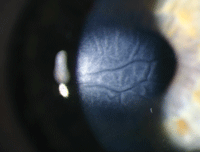 Q: I recently saw a patient who presented with a significant full-thickness, central corneal abrasion. He had LASIK surgery about four years ago with a laser-cut flap. Despite topical antibiotic use, the patient experienced significant diffuse lamellar keratitis (DLK) a few days later. What’s the mechanism that caused such a response years after LASIK? Is there a rationale for topical steroid use in any patient who has had LASIK and experiences a corneal abrasion?
Q: I recently saw a patient who presented with a significant full-thickness, central corneal abrasion. He had LASIK surgery about four years ago with a laser-cut flap. Despite topical antibiotic use, the patient experienced significant diffuse lamellar keratitis (DLK) a few days later. What’s the mechanism that caused such a response years after LASIK? Is there a rationale for topical steroid use in any patient who has had LASIK and experiences a corneal abrasion?
A: “DLK can occur with even trivial trauma at any time following LASIK, even many years out from the original surgery,” says Thomas S. Boland, M.D., of Northeastern Eye Institute in Scranton, Pa. DLK is a non-infectious inflammatory reaction to an interface insult, and one of the more common interface complications after LASIK.
In response to trauma, white blood cells accumulate in the interface between the corneal flap and the underlying stroma. “Once the white blood cells are in place, they release proteolytic enzymes (in an attempt to eliminate or repair the injury caused by the abrasion)—which can lead to loss of tissue and permanent alteration in the corneal shape and clarity,” Dr. Boland says.
Severe, vision-threatening DLK may occur in one in 5,000 cases, while very mild cases may be as frequent as one in 50 cases.1 In mild cases, DLK rarely affects vision and is easily treatable. Left untreated, it can cause permanent damage, including reduction in visual acuity, scarring and stromal melt.
Typically, DLK occurs within the first week after surgery, but late-onset cases have been reported as late as 12 years post-LASIK.1,2 “The most severe cases of DLK that I have seen in clinical practice have followed corneal abrasion years after the original LASIK surgery,” Dr. Boland says. “Because of this, it is my recommendation that any corneal abrasion after LASIK should be treated with topical steroids in addition to prophylactic antibiotics.”

A very severe case of DLK.
His typical regimen includes a topical fluoroquinolone and prednisolone acetate 1% q.i.d., and continuing treatment for approximately 48 hours after complete re-epithelialization. However, if a patient presents with significant DLK, topical steroids are often dosed every hour for the first day or two. “If it’s started promptly after injury, this potentially vision-threatening complication can be averted,” Dr. Boland says.
In more serious cases, a refractive surgeon may need to irrigate and reposition the flap. This technique is used to “wash out” cells and is commonly employed along with frequent topical steroids. Oral steroids can also be useful in some cases before lifting the flap.
Because DLK typically occurs during the immediate postoperative period, some eye care providers may incorrectly assume the interface inflammation is due to infectious keratitis. While interface inflammation can present in either condition, the treatment protocols are completely different, so a definitive diagnosis is crucial.2
To that end, carefully examine the infiltrate—an accumulation of white blood cells at the interface indicates DLK, whereas a focused infiltrate is characteristic of infectious keratitis. Watch closely for signs of infection, such as increased pain, anterior chamber reaction and mucopurulent discharge.
A corneal masquerade can present when high pressure results from a steroid response. Unlike in DLK, an atypical or peculiar interface change can result from the pressure being high. The cornea looks different than it might when there’s edema from high pressure due to the interface created following surgery. Of course, the time frames are different—topical steroid responses occur later than a DLK response in the interface.
1. Colatrella N, Varanelli JR. Management of LASIK complications. Presented at: EyeWest Eye Conference, October 2012; Cleveland.
2. Gritz DC. LASIK interface keratitis: epidemiology, diagnosis and care. Curr Opin Ophthalmol. 2011 Jul;22(4):251-5.

